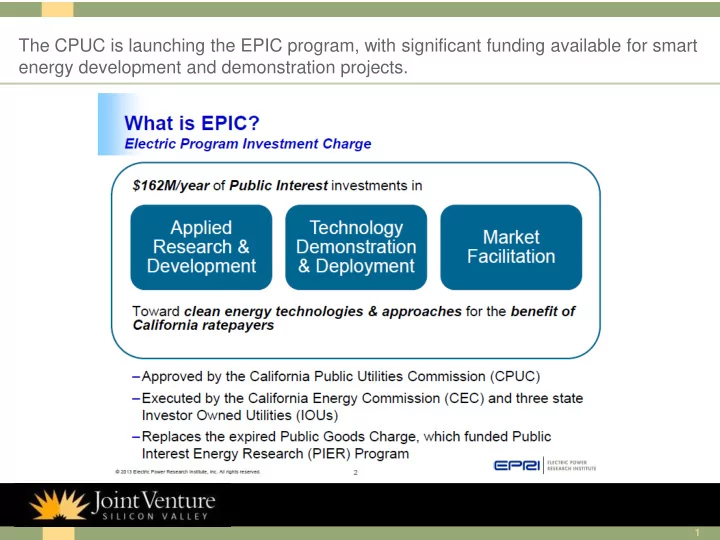

The CPUC is launching the EPIC program, with significant funding available for smart energy development and demonstration projects. 1
The California Energy Commission will manage a majority of the EPIC investment funds ($115 million annually). 2
The CEC’s strategic investment plan defines 18 ‘strategic objectives’ encompassing a total of 65 R&D and demonstration initiatives. 3
Many EPIC funding areas and initiatives appear to be a good fit with the scope and goals of the SEEDZ Initiative (~29 of 65) Energy Efficiency and Demand Response Smart Grid-Enabling Clean Technology • • Next-Generation Lighting Systems Distribution Grid Automation to Support Integration of Distributed Energy • Energy Efficiency in HVAC Systems Resources and Grid Reliability • • Building Occupant Behaviors and Sustained Improvement in Energy Smart Grid Integration with Customer-Premise Networks Efficiency • • Interoperability Test Tools for Distributed Energy Resources (DG, V2G, Storage) Building Energy Efficiency Retrofit Packages • Plug Load Reduction • Strategies for Grid-Level Energy Storage to Support Improved Performance • Zero Net Energy (ZNE) Strategies and Reliability • High-Fidelity Metering and Telemetry, to Enable Market Participation • Smart Plug-In Electric Vehicle (PEV) Charging and Demand-Side Management from Distributed Energy Resources (DR, DG, PEVs and Storage) • Grid Communication Interfaces for PEV Charging and Vehicle-to-Grid Services • Demand Response Strategies, Incorporating Distributed Energy Resources and Enabling Dynamic Pricing Cross-Cutting • Integration of Distributed Energy Resources (DR, DG, PEVs, Storage) to • Establishment of a Regional Innovation Cluster to Support Early-Stage Energy Support Grid Stability on a Community Scale Entrepreneurs • Strategies for Integration of Automated Demand Response (ADR) with • Establishment of a Demonstration Testing and Verification Center Other Customer-Side Distributed Energy Resources (Storage, DG) Clean Generation Market Facilitation • Pilot Demonstration for Localized Energy Resource Market • Solar PV Integration and Interoperability • Local Government Needs Assessment to Identify Gaps Impeding Clean Energy Deployment Technology Demonstration and Deployment • Education on Clean Energy Planning and Permitting for Local Governments • On-site Demonstration and Economic Verification of Emerging Energy- • Efficiency and Demand Response Solutions Develop Training/Apprenticeship Programs for Smart Energy Deployment • Demonstration of Integrated Demand-Side Management Benefits, • across EE, DR, DG, Storage and/or other Resources Create a Web Portal to Connect Smart Energy Market Participants with EPIC • Design Approaches for Integration of Localized Energy Generation, Projects and Results • Efficiency and Systems into Community Environments Conduct Technology Forums to Connect Smart Energy Innovators with • Demonstrate Vehicle-to-Grid and Second-Use Vehicle Battery Apps Investors, Customers, Job Seekers, and Policymakers 4
Responding to the EPIC SEEDZ Survey (Sample) SEEDZ EPIC Initiative Participation Survey Please briefly review each initiative topic and description, and indicate your organization's general level of interest in participation (Y or N) in column W. If Yes, please indicate with an 'X' the type(s) of involvement you potentially envision for your organization, in columns X, Y, Z, and AA. If Interest, Likely Type(s) of Involvement Host Technology Proposal & Other Facility(ies) Solution Project Interest? (TBD) Intiative Topic Expanded Description (Y/N) for Solution Provider Leadership S1.1 Next-Generation Lighting Systems Lighting represents 25% of California electricity use. This initiative conducts research promoting development and implementation of new technologies and market applications for improved efficiency and performance in lighting systems and components. This includes whole lighting systems and components; simulation tools to encourage cost- effective daylighting and best retrofit strategies; control systems to integrate electric lighting with natural lighting, and fixtures with better light quality and consumer acceptance; self-commissioning systems to improve performance and ease of installation; lab, bench-scale, and pilot programs to estimate savings and inform standards and incentives; public workshops to identify lighting-related R&D needs. S1.2 Energy Efficiency in HVAC Systems HVAC consumes 42% of electricity in the commercial sector, and loads are highest during peak demand periods. This initiative focuses on: improving efficiency of existing HVAC systems; developing advanced EE equipment and systems optimized for CA climates; developing fault detection and diagnostic tools and protocols to ensure continued HVAC system performance and efficiency over time; develop simulation models and performance modeling rule sets to promote utility incentives and compliance credit for innovative systems; pilot programs for candidate technologies; public workshops to identify HVAC-related R&D needs. S1.4 Building Occupant Behaviors and Energy use in buildings is dependent on occupant behavior, and is affected by purchasing decisions on appliances and Sustained Improvement in Energy electrical devices. This initiative focuses on factors that motivate customers and tenants to make energy-efficient Efficiency purchases, and operate buildings efficiently, including: determining types of energy information that motivates energy efficiency in purchased equipment, and efficient operation thereof; how such information should be provided and/or displayed; analysis of smart technologies available on the market that can program and automate energy efficiency versus be controlled by the end user; analysis of persistance of behavioral energy efficiency programs; determining how best to collect, disaggregate, and interpret energy data provided by building occupants and owners, smart meters and utility companies; demonstrating related technologies and promoting market education and adoption. 5
Next steps: How do we best mobilize resources to pursue and win EPIC funding opportunities of interest to SEEDZ participants? • Complete your survey and indicate type of involvement! - Phil Metz phil.metz@jointventure.org - Don Bray don.bray@jointventure.org • We will determine and integrate interest among SEEDZ stakeholders in pursuing specific investment opportunities: as a prospective proposal & project ‘lead’ organization, committing expertise and resources to - development of funding proposal / PON response - as a hosting facility for solution, committing resources as a demonstration site and study participant - as a technology solution provider • Track and communicate likely PON schedule to SEEDZ members • Convene parties around specific initiative(s) of high interest, to determine approach, roles • Continue to meet with CEC staff and leadership to familiarize them with SEEDZ effort, and determine best leverage points 6
Recommend
More recommend